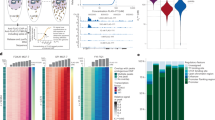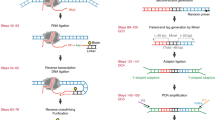Abstract
Understanding how eukaryotic enhancers are bound and regulated by specific combinations of transcription factors is still a major challenge. To better map transcription factor binding genome-wide at nucleotide resolution in vivo, we have developed a robust ChIP-exo protocol called ChIP-nexus (chromatin immunoprecipitation experiments with nucleotide resolution through exonuclease, unique barcode and single ligation), which utilizes an efficient DNA self-circularization step during library preparation. Application of ChIP-nexus to four proteins—human TBP and Drosophila NFkB, Twist and Max—shows that it outperforms existing ChIP protocols in resolution and specificity, pinpoints relevant binding sites within enhancers containing multiple binding motifs, and allows for the analysis of in vivo binding specificities. Notably, we show that Max frequently interacts with DNA sequences next to its motif, and that this binding pattern correlates with local DNA-sequence features such as DNA shape. ChIP-nexus will be broadly applicable to the study of in vivo transcription factor binding specificity and its relationship to cis-regulatory changes in humans and model organisms.
This is a preview of subscription content, access via your institution
Access options
Subscribe to this journal
Receive 12 print issues and online access
$209.00 per year
only $17.42 per issue
Buy this article
- Purchase on Springer Link
- Instant access to full article PDF
Prices may be subject to local taxes which are calculated during checkout




Similar content being viewed by others
References
Spitz, F. & Furlong, E.E. Transcription factors: from enhancer binding to developmental control. Nat. Rev. Genet. 13, 613–626 (2012).
Bardet, A.F. et al. Identification of transcription factor binding sites from ChIP-seq data at high resolution. Bioinformatics 29, 2705–2713 (2013).
Rhee, H.S. & Pugh, B.F. Comprehensive genome-wide protein-DNA interactions detected at single-nucleotide resolution. Cell 147, 1408–1419 (2011).
Rhee, H.S. & Pugh, B.F. ChIP-exo method for identifying genomic location of DNA-binding proteins with near-single-nucleotide accuracy. Curr. Protoc. Mol. Biol. Chapter 21, Unit 21.24 (2012).
Rhee, H.S. & Pugh, B.F. Genome-wide structure and organization of eukaryotic pre-initiation complexes. Nature 483, 295–301 (2012).
Yen, K., Vinayachandran, V., Batta, K., Koerber, R.T. & Pugh, B.F. Genome-wide nucleosome specificity and directionality of chromatin remodelers. Cell 149, 1461–1473 (2012).
Kivioja, T. et al. Counting absolute numbers of molecules using unique molecular identifiers. Nat. Methods 9, 72–74 (2012).
Casbon, J.A., Osborne, R.J., Brenner, S. & Lichtenstein, C.P. A method for counting PCR template molecules with application to next-generation sequencing. Nucleic Acids Res. 39, e81 (2011).
Venters, B.J. & Pugh, B.F. Genomic organization of human transcription initiation complexes. Nature 502, 53–58 (2013).
Serandour, A.A., Brown, G.D., Cohen, J.D. & Carroll, J.S. Development of an Illumina-based ChIP-exonuclease method provides insight into FoxA1-DNA binding properties. Genome Biol. 14, R147 (2013).
König, J. et al. iCLIP reveals the function of hnRNP particles in splicing at individual nucleotide resolution. Nat. Struct. Mol. Biol. 17, 909–915 (2010).
Huang, J.D., Schwyter, D.H., Shirokawa, J.M. & Courey, A.J. The interplay between multiple enhancer and silencer elements defines the pattern of decapentaplegic expression. Genes Dev. 7, 694–704 (1993).
Fakhouri, W.D. et al. Deciphering a transcriptional regulatory code: modeling short-range repression in the Drosophila embryo. Mol. Syst. Biol. 6, 341 (2010).
Ip, Y.T., Park, R.E., Kosman, D., Bier, E. & Levine, M. The dorsal gradient morphogen regulates stripes of rhomboid expression in the presumptive neuroectoderm of the Drosophila embryo. Genes Dev. 6, 1728–1739 (1992).
Zinzen, R.P., Senger, K., Levine, M. & Papatsenko, D. Computational models for neurogenic gene expression in the Drosophila embryo. Curr. Biol. 16, 1358–1365 (2006).
Szymanski, P. & Levine, M. Multiple modes of dorsal-bHLH transcriptional synergy in the Drosophila embryo. EMBO J. 14, 2229–2238 (1995).
Ozdemir, A. et al. High resolution mapping of Twist to DNA in Drosophila embryos: efficient functional analysis and evolutionary conservation. Genome Res. 21, 566–577 (2011).
Liu, X., Lee, C.K., Granek, J.A., Clarke, N.D. & Lieb, J.D. Whole-genome comparison of Leu3 binding in vitro and in vivo reveals the importance of nucleosome occupancy in target site selection. Genome Res. 16, 1517–1528 (2006).
Gordân, R. et al. Genomic regions flanking E-box binding sites influence DNA binding specificity of bHLH transcription factors through DNA shape. Cell Rep. 3, 1093–1104 (2013).
Feng, J., Liu, T., Qin, B., Zhang, Y. & Liu, X.S. Identifying ChIP-seq enrichment using MACS. Nat. Protoc. 7, 1728–1740 (2012).
Blackwood, E.M. & Eisenman, R.N. Max: a helix-loop-helix zipper protein that forms a sequence-specific DNA-binding complex with Myc. Science 251, 1211–1217 (1991).
Prendergast, G.C., Lawe, D. & Ziff, E.B. Association of Myn, the murine homolog of max, with c-Myc stimulates methylation-sensitive DNA binding and ras cotransformation. Cell 65, 395–407 (1991).
Ferré-D'Amaré, A.R., Prendergast, G.C., Ziff, E.B. & Burley, S.K. Recognition by Max of its cognate DNA through a dimeric b/HLH/Z domain. Nature 363, 38–45 (1993).
Nair, S.K. & Burley, S.K. X-ray structures of Myc-Max and Mad-Max recognizing DNA. Molecular bases of regulation by proto-oncogenic transcription factors. Cell 112, 193–205 (2003).
Walhout, A.J., Gubbels, J.M., Bernards, R., van der Vliet, P.C. & Timmers, H.T. c-Myc/Max heterodimers bind cooperatively to the E-box sequences located in the first intron of the rat ornithine decarboxylase (ODC) gene. Nucleic Acids Res. 25, 1493–1501 (1997).
Wechsler, D.S., Papoulas, O., Dang, C.V. & Kingston, R.E. Differential binding of c-Myc and Max to nucleosomal DNA. Mol. Cell. Biol. 14, 4097–4107 (1994).
Zhu, L.J. et al. FlyFactorSurvey: a database of Drosophila transcription factor binding specificities determined using the bacterial one-hybrid system. Nucleic Acids Res. 39, D111–D117 (2011).
Rohs, R. et al. The role of DNA shape in protein-DNA recognition. Nature 461, 1248–1253 (2009).
Yang, L. et al. TFBSshape: a motif database for DNA shape features of transcription factor binding sites. Nucleic Acids Res. 42, D148–D155 (2014).
Zhou, T. et al. DNAshape: a method for the high-throughput prediction of DNA structural features on a genomic scale. Nucleic Acids Res. 41, W56–W62 (2013).
Hesselberth, J.R. et al. Global mapping of protein-DNA interactions in vivo by digital genomic footprinting. Nat. Methods 6, 283–289 (2009).
White, M.A., Myers, C.A., Corbo, J.C. & Cohen, B.A. Massively parallel in vivo enhancer assay reveals that highly local features determine the cis-regulatory function of ChIP-seq peaks. Proc. Natl. Acad. Sci. USA 110, 11952–11957 (2013).
Sandmann, T. et al. A core transcriptional network for early mesoderm development in Drosophila melanogaster. Genes Dev. 21, 436–449 (2007).
Zeitlinger, J. et al. Whole-genome ChIP-chip analysis of Dorsal, Twist, and Snail suggests integration of diverse patterning processes in the Drosophila embryo. Genes Dev. 21, 385–390 (2007).
He, Q. et al. High conservation of transcription factor binding and evidence for combinatorial regulation across six Drosophila species. Nat. Genet. 43, 414–420 (2011).
Martin, M. Cutadapt removes adaptor sequences from high-throughput sequencing reads. EMBnet.journal 17, 10–12 (2011).
Langmead, B., Trapnell, C., Pop, M. & Salzberg, S.L. Ultrafast and memory-efficient alignment of short DNA sequences to the human genome. Genome Biol. 10, R25 (2009).
R Development Core Team R: a language and environment for statistical computing. http://www.R-project.org/ (2013).
Gentleman, R.C. et al. Bioconductor: open software development for computational biology and bioinformatics. Genome Biol. 5, R80 (2004).
Li, H. et al. The Sequence Alignment/Map format and SAMtools. Bioinformatics 25, 2078–2079 (2009).
Acknowledgements
We thank M. Blanchette and A. Stark for discussions and R. Krumlauf and R. Mohan for critical comments on the manuscript. This work was funded by the US National Institutes of Health (New Innovator Award 1DP2 OD004561 to J.Z.) and the Stowers Institute for Medical Research.
Author information
Authors and Affiliations
Contributions
Q.H. and J.Z. conceived and designed the ChIP-nexus protocol. Q.H. performed all experiments. J.J. developed all computational analysis tools. Q.H., J.J. and J.Z. analyzed and interpreted the data and wrote the manuscript.
Corresponding author
Ethics declarations
Competing interests
The authors have applied for a patent for ChIP-nexus.
Supplementary information
Supplementary figures and text
Supplementary Figure 1 and Supplementary Protocol 1 (PDF 2694 kb)
Rights and permissions
About this article
Cite this article
He, Q., Johnston, J. & Zeitlinger, J. ChIP-nexus enables improved detection of in vivo transcription factor binding footprints. Nat Biotechnol 33, 395–401 (2015). https://doi.org/10.1038/nbt.3121
Received:
Accepted:
Published:
Issue Date:
DOI: https://doi.org/10.1038/nbt.3121
This article is cited by
-
Discovering covalent inhibitors of protein–protein interactions from trillions of sulfur(VI) fluoride exchange-modified oligonucleotides
Nature Chemistry (2023)
-
A dual role for H2A.Z.1 in modulating the dynamics of RNA polymerase II initiation and elongation
Nature Structural & Molecular Biology (2021)
-
Comparative analysis of ChIP-exo peak-callers: impact of data quality, read duplication and binding subtypes
BMC Bioinformatics (2020)
-
DeepSite: bidirectional LSTM and CNN models for predicting DNA–protein binding
International Journal of Machine Learning and Cybernetics (2020)
-
XL-DNase-seq: improved footprinting of dynamic transcription factors
Epigenetics & Chromatin (2019)



